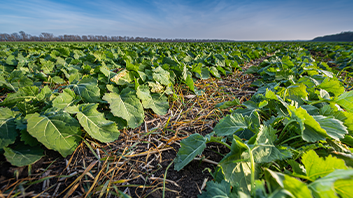Count on Cover Crops, Combat Weeds
Adding cover crops to your production plans can help you win the battle on weed control.

Weed control in today’s crop systems is not as simple as it once was. No longer can growers count on one management practice to deliver clean fields all season long. In fact, troublesome species like Palmer amaranth call for growers to depend on a diverse management toolbox to eradicate pigweed on farm.
In addition, as herbicide resistance becomes more commonplace in the industry, incorporating innovative weed management strategies like implementing cover crops helps farmers to build a nutrient-dense soil profile and helps strengthen their weed control portfolio.
Experience the Benefits
Putting a successful crop in the bin at harvest begins with a thoughtful, year-long plan.
Farmers can look ahead to post-harvest cultural practices like growing cover crops to not only add organic matter back to the soil, but also increase water infiltration rates and the soil’s ability to retain residual moisture after irrigation or rainfall.
But the benefits of growing cover crops go beyond establishing a nutrient-dense soil.
According to Dr. Nick Basinger, University of Georgia assistant professor, cover crops can also make a positive impact on weed control.
In a University of Georgia study investigating the impact of cereal rye, crimson clover and a living mulch on pigweed emergence in a cotton production system without the use of herbicides, Basinger says researchers estimated a 92% reduction in the number of Palmer amaranth seedlings that germinated in cereal rye and living mulch systems when compared to plots without a cover crop. In the living mulch and cereal rye cover crop systems, even fewer plants made it to maturity.1
Basinger says without light, pigweed struggles to germinate—even if other growing conditions are right such as abundant soil moisture and temperature.
“From a weed perspective, what we’re doing with cover crops is creating a physical barrier to prevent it from getting through and then maximizing biomass production before the crop is terminated.”
—Dr. Nick Basinger, University of Georgia assistant professor of weed ecology
The result is a significant reduction in pigweed emergence. If herbicides are used in the production system, Basinger says because fewer plants are being sprayed, the potential for future resistance development is also reduced.
Start With a Plan
Before heading to the field, Basinger advises growers to start small and begin with a plan.
“The biggest thing I’ve experienced in my own research and also in talking with growers is to make sure that you’re ready for the biomass when it is time to plant, roll and spray,” Basinger says.
Once crop management goals are in place, Basinger recommends farmers visit the website specific to his or her region of the country for assistance in determining the best cover crop species and varieties to plant. For example, growers in the South should visit www.southerncovercrops.org for information on species and varieties that might be best suited for weed control in that region.
“We can actually select a cover crop that is specific to weed suppression,” Basinger explains.
After selecting a cover crop variety, focus should turn to equipment as Basinger says growers must make certain the field is prepped for planting and the correct implements are on hand, including a roller crimper.
Consider cereal rye, for example. The cover crop produces an abundance of biomass, according to Dr. Charlie Cahoon, North Carolina State University extension weed specialist.
“Basically, if we can get 6,000 to 8,000 pounds of biomass and then roll or terminate the crop, it creates a mat of residue that can keep some of our summer annual weeds from either coming up completely or being very competitive,” he explains.
While cereal rye is a popular cover crop from a biomass standpoint, Cahoon says legume species like crimson clover help produce nitrogen.
“A lot of folks maybe use that species exclusively or mixed in with cereal rye,” Cahoon says. “If you terminate the legume, it’s a nitrogen fixer. Then, you get some added benefits.”
Still, the bottom line with cover crops is to begin with a plan. If a variety is sowed by aerial broadcast in the fall, for example, harvest can be challenging in crops like cotton.
“If you have a lot of acres and you’re still harvesting your crop, it can be difficult to get the cover crop out on all your acres,” Cahoon says.
Combat Herbicide Resistance
As growers continue to face herbicide resistance, employing production strategies from their management toolbox is key to season-long weed control. Cahoon says the efficacy of cover crops as a suppressant on pigweed have been studied nationwide.
Although not 100% effective, research shows cover crops work extremely well in tandem with residual herbicides and timely post-emergence herbicides, according to Cahoon.2
“Herbicide resistance is a numbers game,” he notes. “So, the fewer weeds that we expose to our post-emergence herbicides, the less chance we get of having herbicide resistance to those herbicides. That adds to the sustainability of our entire system over the long term.”
Not a replacement for residual herbicide, Basinger says cover crops are simply another tool for growers to use from their management toolbox to win the battle on weed control.
Maximize the Weed Control Portfolio
With economic efficiency the bottom line for today’s farmers, Cahoon says they must consider the long-term feasibility of their production schemes. By using cover crops to prolong the technology farmers have become accustomed to for weed control, then eventual sustainability and profitability might be more easily realized.
“The bottom line is any way we can diversify our weed management practices is monumental to the long-term success of farming.”
—Dr. Charlie Cahoon, North Carolina State University extension weed specialist
Basinger encourages farmers to use cover crops as part of integrated weed management.
“Another tool to mitigate weeds, cover crops are an investment in the long-term to slow the potential for future resistance development,” he explains.
Overall, cover crops can help maximize the efficacy of herbicides.
“With cover crops, you are widening the window for [herbicide] application,” Basinger concludes. “You lay a great herbicide program on top of that, and you can have incredible weed control. Plus, you’ll be able to mitigate the development of resistance on your farm and benefit your soil in other ways not related to weed suppression.”
Citations:
1. Nicholas T. Basinger, University of Georgia. Un-published, research ongoing.
2. Lavesta C. Hand, Taylor M. Randell, Robert L. Nichols, Lawrence E. Steckel, Nicholas T. Basinger, A. Stanley Culpepper. First published: 18 September 2021 https://doi.org/10.1002/agj2.20886.
